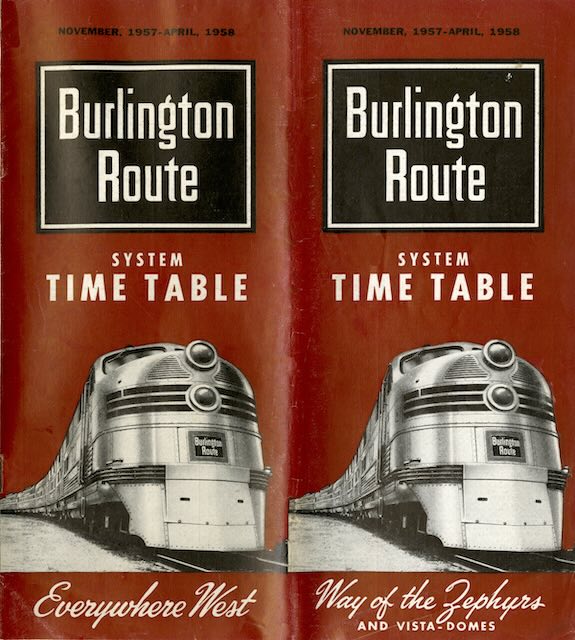I don’t see any attrition of scheduled trains on this timetable, so now is as good a time as any to bring up a subject I’ve mentioned before: Burlington’s sometimes weird way of numbering its trains. Most railroads used successive integers, such as 1 and 2 or 3 and 4, to number most of their trains, usually with odd numbered trains going west and even numbers going east. Burlington followed the even-odd convention but often did not use successive numbers for paired trains.
 Click image to download a 21.5-MB PDF of this 36-page timetable.
Click image to download a 21.5-MB PDF of this 36-page timetable.
The Denver Zephyr, Burlington’s premiere train, was not numbered 1 & 2 but 1 & 10. The Ak-Sar-Ben Zephyr was not numbered 3 & 4 but 3 & 30. The Coloradan was not numbered 19 & 20 but 19 & 6. Chicago-to-Galesburg train 15 was paired with train 2. The St. Louis-Twin Cities Zephyr-Rocket was not numbered 8 & 9 but 8 & 15, which was doubly confusing because there was already a train 15 from Chicago to Galesburg.
A St. Louis-to-Burlington mail train that, like the Denver Zephyr, was also numbered 1 was paired with train 12. Chicago-to-Denver mail train #7 was paired with #14. Chicago-to-Twin Cities mail train #45 was paired with #52. Burlington had plenty of trains with consecutive numbers, and other railroads may have had a few non-consecutively numbered trains, but the Burlington had a lot of them whose number pairs made no sense.
When I raised this issue before, someone suggested that some of the train numbers were already taken and so Burlington had to make do with unpaired numbers. In the case of the Denver Zephyr, for example, before that train was inaugurated Burlington had a Chicago-Denver train called the Overland Express that was numbered 2 and 3. But it also had a train #1 that went from St. Louis to Burlington, which (as in 1957) was paired with #12.
Why did it number a train 2 & 3, leaving 1 isolated? Why did it use the number 1 twice (three times counting the Colorado & Southern?
There were plenty of integers that it wasn’t using at all. When Union Pacific introduced the City trains, most of its other trains used two digit numbers, so it numbered its streamliners 101 & 102, 103 & 104, etc. Why didn’t Burlington number the Denver Zephyr 61 & 62 or some other pair of unused numbers?
Another alternative was to renumber trains, which was not unprecedented. For many years, both Great Northern and Northern Pacific numbered their premiere trains 1 & 2. In 1952, NP renumbered the North Coast Limited 25 & 26 (which were also the numbers Burlington used) while GN renumbered the Empire Builder 31 & 32 (which were not the numbers Burlington used). NP secondary train, the Alaskan, had been 3 & 4, but as the Mainstreeter it was numbered 1 & 2.
Why didn’t Burlington renumber the Overland Express 3 & 4, leaving 1 & 2 for the Denver Zephyr when it introduced the latter train? Or why didn’t it renumber the Denver Zephyr 1 & 2 when the eastbound Overland Express, train 2, disappeared from the timetable in about 1939? Instead, it used #2 for an unnamed Denver-Omaha train, but even that train disappeared in 1942.
Ultimately, these questions are meaningless, as Burlington did what it did. But apparently it did some things more out of habit than for any logical reason.
